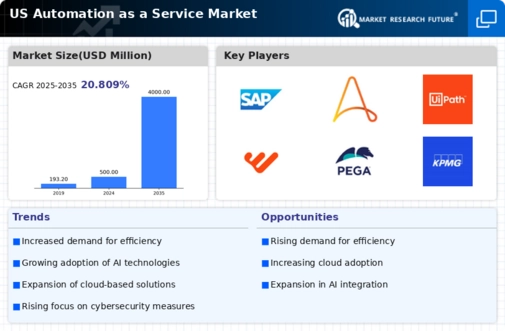Focus on Regulatory Compliance
Regulatory compliance is emerging as a critical driver for the automation as-a-service market. As industries face increasing scrutiny from regulatory bodies, organizations are turning to automation solutions to ensure adherence to compliance standards. Automation can streamline compliance processes, reduce the risk of human error, and provide audit trails that are essential for regulatory reporting. In sectors such as finance and healthcare, where compliance is paramount, the demand for automation services is particularly strong. It is estimated that companies investing in compliance automation can reduce compliance costs by up to 40%. This focus on regulatory compliance not only mitigates risks but also enhances the credibility of organizations within their respective industries, thereby propelling growth in the automation as-a-service market.
Integration of Advanced Analytics
The integration of advanced analytics into the automation as-a-service market is becoming increasingly prevalent. Organizations are leveraging data analytics to gain insights into their operations, enabling them to make informed decisions and optimize processes. This trend is particularly relevant as businesses aim to harness the power of big data. By utilizing analytics, companies can identify inefficiencies and areas for improvement, which can lead to enhanced automation strategies. The market for analytics-driven automation solutions is projected to reach $10 billion by 2026, indicating a robust growth trajectory. This integration not only enhances the capabilities of automation services but also positions organizations to respond swiftly to market changes, thereby solidifying their competitive edge in the automation as-a-service market.
Shift Towards Cloud-Based Solutions
The shift towards cloud-based solutions is a significant driver in the automation as-a-service market. Organizations are increasingly adopting cloud technologies to facilitate scalability and flexibility in their operations. Cloud-based automation services allow businesses to deploy solutions rapidly without the need for extensive on-premises infrastructure. This transition is particularly appealing to small and medium-sized enterprises (SMEs) that may lack the resources for traditional automation setups. Current estimates suggest that the cloud segment of the automation market could account for over 60% of total market revenue by 2027. This trend underscores the growing preference for agile, cost-effective solutions that cloud-based automation services provide, thereby enhancing the overall appeal of the automation as-a-service market.
Emergence of Industry-Specific Solutions
The emergence of industry-specific solutions is shaping the landscape of the automation as-a-service market. As businesses seek tailored automation services that address their unique challenges, providers are increasingly developing specialized solutions for various sectors. This trend is evident in industries such as healthcare, finance, and retail, where automation can be customized to meet specific operational needs. For instance, automation solutions in healthcare can streamline patient management processes, while those in finance can enhance transaction processing. The market for industry-specific automation solutions is projected to grow significantly, with estimates suggesting a CAGR of 20% over the next five years. This focus on customization not only enhances the effectiveness of automation services but also drives adoption across diverse sectors, thereby contributing to the overall growth of the automation as-a-service market.
Rising Demand for Operational Efficiency
The The automation as-a-service market is experiencing a notable surge in demand. This demand is driven by organizations striving for operational efficiency. Companies are increasingly recognizing the potential of automation to streamline processes, reduce manual errors, and enhance productivity. According to recent data, businesses that implement automation solutions can achieve efficiency gains of up to 30%. This trend is particularly pronounced in sectors such as manufacturing and logistics, where operational costs are critical. As organizations seek to optimize their workflows, the automation as-a-service market is positioned to grow, with projections indicating a compound annual growth rate (CAGR) of 25% over the next five years. This growth reflects a broader shift towards integrating technology into everyday operations, thereby reinforcing the importance of automation in achieving strategic business objectives.


























Leave a Comment